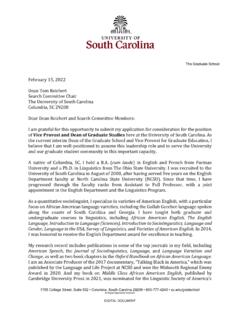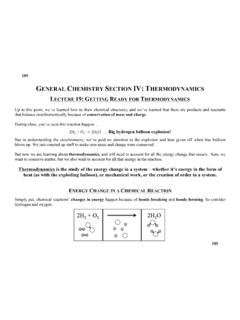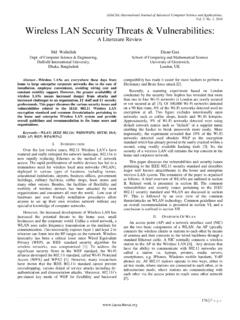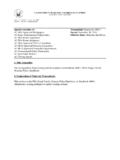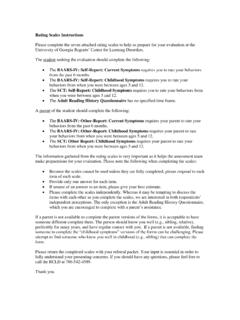Transcription of Biosafety Level 2 BSL 2 Criteria Section IV
1 LABORATORY Biosafety Level 2 Criteria Biosafety in Microbiological and Biomedical Laboratories (BMBL) 6th Edition Section IV Biosafety Level 2 Biosafety Level 2 (BSL-2) builds upon BSL-1. BSL-2 is suitable for work with agents associated with human disease and pose moderate hazards to personnel and the environment. BSL-2 differs from BSL-1 primarily because: 1) laboratory personnel receive specific training in handling pathogenic agents and are supervised by scientists competent in handling infectious agents and associated procedures; 2) access to the laboratory is restricted when work is being conducted; and 3) all procedures in which infectious aerosols or splashes may be created are conducted in BSCs or other physical containment equipment. The following standard and special practices, safety equipment, and facility specifications are recommended for BSL-2. A. Standard Microbiological Practices 1. The laboratory supervisor enforces the institutional policies that control safety in and access to the laboratory.
2 2. The laboratory supervisor ensures that laboratory personnel receive appropriate training regarding their duties, potential hazards, manipulations of infectious agents, necessary precautions to minimize exposures, and hazard/exposure evaluation procedures ( , physical hazards, splashes, aerosolization) and that appropriate records are maintained. Personnel receive annual updates and additional training when equipment, procedures, or policies change. All persons entering the facility are advised of the potential hazards, are instructed on the appropriate safeguards, and read and follow instructions on practices and procedures. An institutional policy regarding visitor training, occupational health requirements, and safety communication is considered. 3. Personal health status may affect an individual s susceptibility to infection and ability to receive available immunizations or prophylactic interventions. Therefore, all personnel, and particularly those of reproductive age and/or those having conditions that may predispose them to increased risk for infection ( , organ transplant, medical immunosuppressive agents), are provided information regarding immune competence and susceptibility to infectious agents.
3 Individuals having such conditions are encouraged to self-identify to the institution s healthcare provider for appropriate counseling and guidance. See Section VII. 4. A safety manual specific to the facility is prepared or adopted in consultation with the facility director and appropriate safety professionals. The safety manual is available, accessible, and periodically reviewed and updated, as necessary. a. The safety manual contains sufficient information to describe the Biosafety and containment procedures for the organisms and biological materials in use, appropriate agent-specific decontamination methods, and the work performed. b. The safety manual contains or references protocols for emergency situations, including exposures, medical emergencies, facility malfunctions, and other potential emergencies. Training in emergency response procedures is provided to emergency response personnel and other responsible staff according to institutional policies. 5. A sign incorporating the universal biohazard symbol is posted at the entrance to the laboratory when infectious materials are present.
4 Posted information includes: the laboratory s Biosafety Level , the supervisor s or other responsible personnel s name and telephone number, PPE requirements, general occupational health requirements ( , immunizations, respiratory protection), and required procedures for entering and exiting the laboratory. Agent information is posted in accordance with the institutional policy. 6. Long hair is restrained so that it cannot contact hands, specimens, containers, or equipment. 7. Gloves are worn to protect hands from exposure to hazardous materials. a. Glove selection is based on an appropriate risk assessment. b. Gloves are not worn outside the laboratory. c. Change gloves when contaminated, glove integrity is compromised, or when otherwise necessary. d. Do not wash or reuse disposable gloves and dispose of used gloves with other contaminated laboratory waste. 8. Gloves and other PPE are removed in a manner that minimizes personal contamination and transfer of infectious materials outside of the areas where infectious materials and/or animals are housed or manipulated.
5 9. Persons wash their hands after working with potentially hazardous materials and before leaving the laboratory. 10. Eating, drinking, smoking, handling contact lenses, applying cosmetics, and storing food for human consumption are not permitted in laboratory areas. Food is stored outside the laboratory area. 11. Mouth pipetting is prohibited. Mechanical pipetting devices are used. 12. Policies for the safe handling of sharps, such as needles, scalpels, pipettes, and broken glassware are developed, implemented, and followed; policies are consistent with applicable state, federal, and local requirements. Whenever practical, laboratory supervisors adopt improved engineering and work practice controls that reduce risk of sharps injuries. Precautions are always taken with sharp items. These include: a. Plasticware is substituted for glassware whenever possible. b. Use of needles and syringes or other sharp instruments is limited in the laboratory and is restricted to situations where there is no alternative ( , parenteral injection, blood collection, or aspiration of fluids from laboratory animals or diaphragm bottles).
6 Active or passive needle-based safety devices are to be used whenever possible. i. Uncapping of needles is performed in such a manner to reduce the potential for recoil causing an accidental needlestick. ii. Needles are not bent, sheared, broken, recapped, removed from disposable syringes, or otherwise manipulated by hand before disposal. iii. If absolutely necessary to remove a needle from a syringe ( , to prevent lysing blood cells) or recap a needle ( , loading syringes in one room and injecting animals in another), a hands-free device or comparable safety procedure must be used ( , a needle remover on a sharps container, the use of forceps to hold the cap when recapping a needle). iv. Used, disposable needles and syringes are carefully placed in puncture-resistant containers used for sharps disposal immediately after use. The sharps disposal container is located as close to the point of use as possible. c. Non-disposable sharps are placed in a hard-walled container for transport to a processing area for decontamination, preferably by autoclaving.
7 D. Broken glassware is not handled directly. Instead, it is removed using a brush and dustpan, tongs, or forceps. 13. Perform all procedures to minimize the creation of splashes and/or aerosols. 14. Decontaminate work surfaces after completion of work and after any spill or splash of potentially infectious material with appropriate disinfectant. Spills involving infectious materials are contained, decontaminated, and cleaned up by staff who are properly trained and equipped to work with infectious material. A spill procedure is developed and posted within the laboratory. 15. Decontaminate all cultures, stocks, and other potentially infectious materials before disposal using an effective method, consistent with applicable institutional, local, and state requirements. Depending on where the decontamination will be performed, the following methods are used prior to transport: a. Materials to be decontaminated outside of the immediate laboratory are placed in a durable, leak-proof container and secured for transport.
8 For infectious materials, the outer surface of the container is disinfected prior to moving materials and the transport container has a universal biohazard label. b. Materials to be removed from the facility for decontamination are packed in accordance with applicable local, state, and federal regulations. 16. An effective integrated pest management program is implemented. See Appendix G. 17. Animals and plants not associated with the work being performed are not permitted in the laboratory. B. Special Practices 1. Access to the laboratory is controlled when work is being conducted. 2. The laboratory supervisor is responsible for ensuring that laboratory personnel demonstrate proficiency in standard microbiological practices and techniques for working with agents requiring BSL-2 containment. 3. Laboratory personnel are provided medical surveillance, as appropriate, and offered available immunizations for agents handled or potentially present in the laboratory. 4. Properly maintained BSCs or other physical containment devices are used, when possible, whenever: a.
9 Procedures with a potential for creating infectious aerosols or splashes are conducted. These include pipetting, centrifuging, grinding, blending, shaking, mixing, sonicating, opening containers of infectious materials, inoculating animals intranasally, and harvesting infected tissues from animals or eggs. b. High concentrations or large volumes of infectious agents are used. Such materials may be centrifuged in the open laboratory using sealed rotors or centrifuge safety cups with loading and unloading of the rotors and centrifuge safety cups in the BSC or another containment device. c. If it is not possible to perform a procedure within a BSC or other physical containment device, a combination of appropriate personal protective equipment and administrative controls are used, based on a risk assessment. C. Safety Equipment (Primary Barriers and Personal Protective Equipment) 1. Protective laboratory coats, gowns, or uniforms designated for laboratory use are worn while working with hazardous materials and removed before leaving for non-laboratory areas ( , cafeteria, library, and administrative offices).
10 Protective clothing is disposed of appropriately or deposited for laundering by the institution. Laboratory clothing is not taken home. 2. Eye protection and face protection ( , safety glasses, goggles, mask, face shield or other splatter guard) are used for manipulations or activities that may result in splashes or sprays of infectious or other hazardous materials. Eye protection and face protection are disposed of with other contaminated laboratory waste or decontaminated after use. 3. The risk assessment considers whether respiratory protection is needed for the work with hazardous materials. If needed, relevant staff are enrolled in a properly constituted respiratory protection program. 4. In circumstances where research animals are present in the laboratory, the risk assessment considers appropriate eye, face, and respiratory protection, as well as potential animal allergens. D. Laboratory Facilities (Secondary Barriers) 1. Laboratory doors are self-closing and have locks in accordance with the institutional policies.



